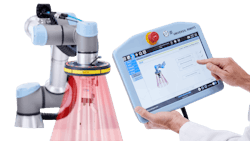Why would a cobot need more sensors to provide a safe environment?
Before we discuss why a cobot may need more sensors to be functionally safe, let’s understand the objective of functional safety. Functional safety has the objective of freedom of operations based on knowledge of operations under the assumption that there is an unacceptable risk of physical injury or damage to a person’s health directly or indirectly.
Convoluted? Yes. Like many things engineering-related, we are trying to control the variability of the environment.
Get your subscription to Control Design’s daily newsletter.
Putting humans and robots—insert “cobots,” but really a cobot is a robot—in the same space means we have lots of variability. What people take for granted as they get comfortable with robots is that robots do not have depth perception.
The Sick End-of-Arm-Safeguard (EOAS), which is also available through the Universal Robots (UR) ecosystem can be integrated with UR’s cobots.
Picture being at the dinner table, and you are one of five teenagers that play sports, and there is one pork chop left in the center of the table. What is the probability of more than one teenager reaching for a pork chop at the time that Mom says that it’s available for whoever wants it?
The assumption is that you can reach for it without being poked by a fork or a knife. All of the siblings can see the pork chop and the table and the bowl, and all of the other siblings. A robot cannot.
Current technology may provide feedback for a robot to “sense” where other robots are, but robots generally still do not know they have reached the end of something or there is an obstruction in their path, unless they have a force sensor on the end effector. If that is assumed with grippers, then an injury—perhaps a fork in the hand—might already have occurred.
If the Sick EOAS is applied, then the fork never comes down for the pork chop until the hand is out of the way, and, by that time, the pork chop is likely gone.
It is a good thing that robots do not eat pork chops.
Why? Undoubtedly, the more comfortable that humans are working with robots, the more likely humans and robots are going to be working side by side and picking from the same bin. How do you make it safe? Give the robot the eyesight to know when to continue its path and when not to.
Engineering EOAS is a functional safety safeguard because it is human nature to take for granted that the robot you are working with can see your hand. It cannot.
Its motivation is not hunger, but even a young man moving his hand down to make a motion to pick up a pork chop may not be able to avoid accidently grazing the slower siblings’ hands. The robot will not change its path or stop until the pressure force is felt by the obstruction.
On a downward motion, that pressure could be too late. EOAS will protect the human and essentially the robot, adding to functional safety of robot/human collaboration.
About the Author
Tobey Strauch
Arconic Davenport
Tobey Strauch is currently managing brownfield installations for controls upgrades at Arconic Davenport. She has previously worked as principal controls engineer and before getting her bachelor’s in electrical engineering, was a telecommunications network technician. She has 20 plus years in automation and controls. She has commissioned systems, programmed PLCs and robots, and SCADAs, as well as managed maintenance crews. She has a broad mix of mechatronics with process control. She enjoys solving problems with Matlab and Simscape. Contact her at [email protected].

Leaders relevant to this article:

